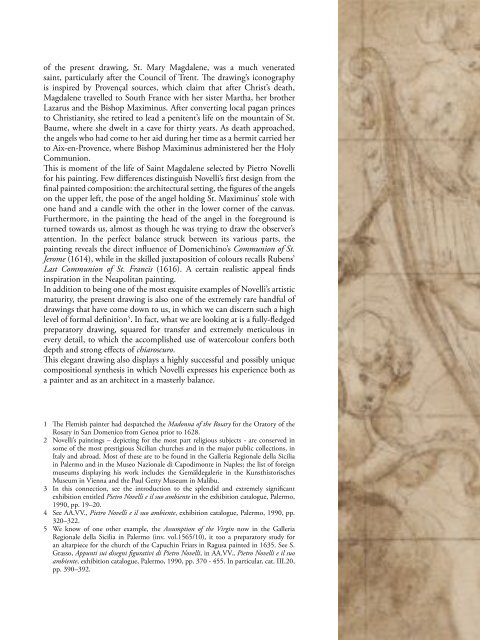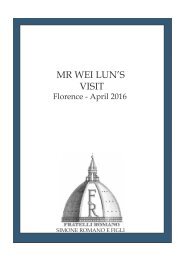A selection of master drawings 2016
- No tags were found...
You also want an ePaper? Increase the reach of your titles
YUMPU automatically turns print PDFs into web optimized ePapers that Google loves.
<strong>of</strong> the present drawing, St. Mary Magdalene, was a much venerated<br />
saint, particularly after the Council <strong>of</strong> Trent. The drawing’s iconography<br />
is inspired by Provençal sources, which claim that after Christ’s death,<br />
Magdalene travelled to South France with her sister Martha, her brother<br />
Lazarus and the Bishop Maximinus. After converting local pagan princes<br />
to Christianity, she retired to lead a penitent’s life on the mountain <strong>of</strong> St.<br />
Baume, where she dwelt in a cave for thirty years. As death approached,<br />
the angels who had come to her aid during her time as a hermit carried her<br />
to Aix-en-Provence, where Bishop Maximinus administered her the Holy<br />
Communion.<br />
This is moment <strong>of</strong> the life <strong>of</strong> Saint Magdalene selected by Pietro Novelli<br />
for his painting. Few differences distinguish Novelli’s first design from the<br />
final painted composition: the architectural setting, the figures <strong>of</strong> the angels<br />
on the upper left, the pose <strong>of</strong> the angel holding St. Maximinus’ stole with<br />
one hand and a candle with the other in the lower corner <strong>of</strong> the canvas.<br />
Furthermore, in the painting the head <strong>of</strong> the angel in the foreground is<br />
turned towards us, almost as though he was trying to draw the observer’s<br />
attention. In the perfect balance struck between its various parts, the<br />
painting reveals the direct influence <strong>of</strong> Domenichino’s Communion <strong>of</strong> St.<br />
Jerome (1614), while in the skilled juxtaposition <strong>of</strong> colours recalls Rubens’<br />
Last Communion <strong>of</strong> St. Francis (1616). A certain realistic appeal finds<br />
inspiration in the Neapolitan painting.<br />
In addition to being one <strong>of</strong> the most exquisite examples <strong>of</strong> Novelli’s artistic<br />
maturity, the present drawing is also one <strong>of</strong> the extremely rare handful <strong>of</strong><br />
<strong>drawings</strong> that have come down to us, in which we can discern such a high<br />
level <strong>of</strong> formal definition 5 . In fact, what we are looking at is a fully-fledged<br />
preparatory drawing, squared for transfer and extremely meticulous in<br />
every detail, to which the accomplished use <strong>of</strong> watercolour confers both<br />
depth and strong effects <strong>of</strong> chiaroscuro.<br />
This elegant drawing also displays a highly successful and possibly unique<br />
compositional synthesis in which Novelli expresses his experience both as<br />
a painter and as an architect in a <strong>master</strong>ly balance.<br />
1 The Flemish painter had despatched the Madonna <strong>of</strong> the Rosary for the Oratory <strong>of</strong> the<br />
Rosary in San Domenico from Genoa prior to 1628.<br />
2 Novelli’s paintings – depicting for the most part religious subjects - are conserved in<br />
some <strong>of</strong> the most prestigious Sicilian churches and in the major public collections, in<br />
Italy and abroad. Most <strong>of</strong> these are to be found in the Galleria Regionale della Sicilia<br />
in Palermo and in the Museo Nazionale di Capodimonte in Naples; the list <strong>of</strong> foreign<br />
museums displaying his work includes the Gemäldegalerie in the Kunsthistorisches<br />
Museum in Vienna and the Paul Getty Museum in Malibu.<br />
3 In this connection, see the introduction to the splendid and extremely significant<br />
exhibition entitled Pietro Novelli e il suo ambiente in the exhibition catalogue, Palermo,<br />
1990, pp. 19–20.<br />
4 See AA.VV., Pietro Novelli e il suo ambiente, exhibition catalogue, Palermo, 1990, pp.<br />
320–322.<br />
5 We know <strong>of</strong> one other example, the Assumption <strong>of</strong> the Virgin now in the Galleria<br />
Regionale della Sicilia in Palermo (inv. vol.1565/10), it too a preparatory study for<br />
an altarpiece for the church <strong>of</strong> the Capuchin Friars in Ragusa painted in 1635. See S.<br />
Grasso, Appunti sui disegni figurativi di Pietro Novelli, in AA.VV., Pietro Novelli e il suo<br />
ambiente, exhibition catalogue, Palermo, 1990, pp. 370 - 455. In particular, cat. III.20,<br />
pp. 390–392.





